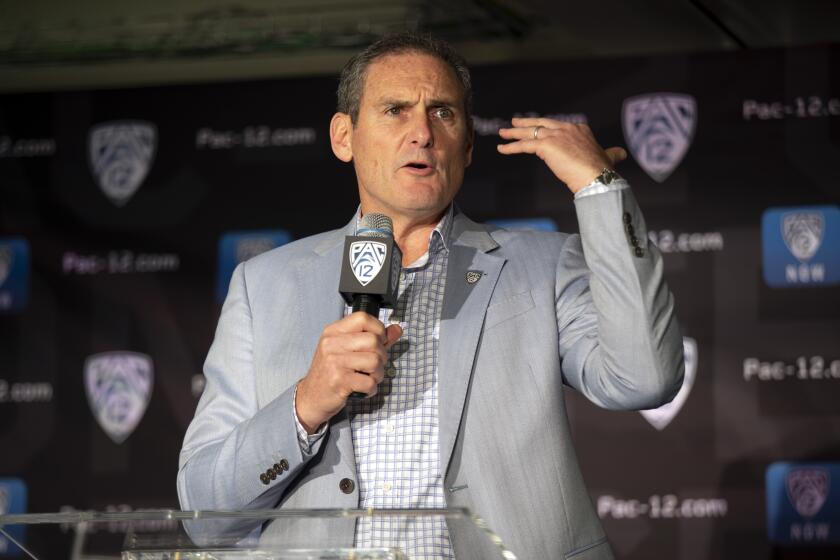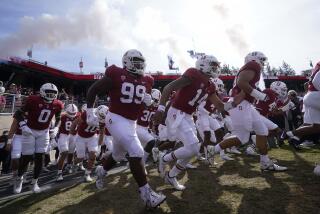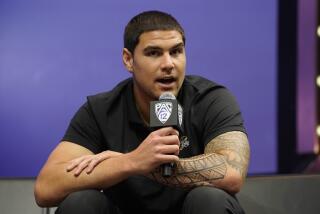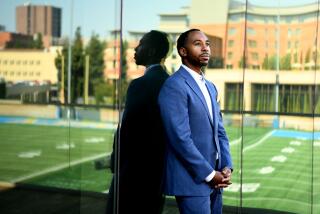How can college campuses be safe for athletes but not students? Put money on football

- Share via
The band room is silent. The biology labs are shuttered. The library is locked.
But hey, football players, come on in!
Classes are on laptops. Seminars are webinars. Graduation ceremonies are on Zoom.
But hey, football players, you better show up!
After two months of being closed during the COVID-19 pandemic, despite risks that still are keeping some entire cities shut down, giant universities everywhere have decided to crack open one of their doors.
Not surprisingly, it is the door that leads to the money.
Last week, the NCAA decided to allow voluntary on-campus workouts for all Division 1 sports beginning June 1. On Tuesday, the Pac-12 Conference joined the national party by announcing it would allow those workouts to begin as soon as June 15.
The Pac-12 Conference voted Tuesday to allow voluntary, on-campus workouts for all athletes beginning as soon as June 15.
While the timing of every Power Five school’s reopening is yet unknown — USC and UCLA have yet to announce a date — one thing is clear. Rarely has the term, “student-athlete” been such an insultingly ridiculous illusion.
While the students are ordered to stay home, the athletes are being essentially ordered to go back to work? It’s not yet safe for the student body president, but it’s totally safe for the quarterback? It’s too risky to sit in a classroom, but cool to hang out in a weight room?
The workout facilities soon will be open to athletes in all sports, midfielders and third basemen and sprinters alike, but the decision is obviously based on one sport only.
It’s all about football. The Power-Five school’s economic structure desperately requires a football season, and, for that, they desperately need in-shape players.
Sack the risks. Block the unknowns. Blitz common sense. Strap it on. Please?
”If you cancel the football season, the entire business model of most athletic departments would crumble,” said Paul Swangard, marketing consultant and longtime instructor of sports brand strategy at Oregon. “Everyone knew the issues that come with being so reliant on such a cash cow, but nobody had a scenario in which it goes away. So now everyone is trying to get it back.”
Studies have shown that football at most Division I schools earns more revenue than the other sports combined. In some places, the football program accounts for more than 70% of an athletic department’s revenue. Approximately 85% of USC’s projected revenue comes from football.
According to a Washington University report commissioned by ESPN, each of the 65 Power-Five schools will lose an average of $62 million in football revenue if there is no season. That figure covers everything from tickets to television rights. That’s a lot of money being generated by essentially unpaid labor, and so it is not surprising that officials will say anything to get those kids back to work.
Larry Scott, the Pac-12 commissioner whose misguided leadership has turned the conference into a national punchline, actually posited that the players would be safer on campus than at home.
Pac-12 Commissioner Larry Scott said that student-athletes would be safer and in a healthier situation if they were on campus in the summer.
During a recent interview on CNN, Scott said, “In most cases, we feel that student-athletes will be in a safer position and a healthier position if they can have access to the world-class medical care, supervision and support that they can get on their campuses.”
Really? If sheltering on campus was safer, then why weren’t we all quarantining on campuses? Why were the dorms emptied instead of filled? Why has your college-age child spent the last two months on your couch instead of the quad?
In a Zoom interview with West Coast Sports Associates, new USC athletic director Mike Bohn doubled down on the dumb by saying, “a student-athlete is safer in an intercollegiate athletic enterprise’s offices, training rooms, than they are anywhere else.”
Right, they’re safer because they’ll be surrounded by dozens of other football players in a locker room culture that is the opposite of social distancing, safer because they can train for a football season while standing six feet apart and wearing a mask. ... safer how, actually?
“Depending on their home environment, it will be safer for some, but for a large portion, it might not be safer,” said Dr. Geoff Dreher, assistant professor of orthopaedic surgery at The John Hopkins University School of Medicine in Baltimore. “Either way, whenever you change your quarantine circle, there are inherent risks with new contacts.”
International student-athletes at UCLA and USC have found that a global pandemic can bring about long waits to get home and days spent in isolation.
Dreher, who specializes in sports medicine, said parents of athletes need to ask questions about protocols involving things such as living conditions, food service and what happens if someone contracts the virus.
“Those are difficult questions to answer,” he said. “Right now, allowing anyone back on campus is inherently more risky, and hopefully they’re doing the best they can to mitigate that risk.”
He added, “I’m cautious with the optics with why they are truly bringing them back. … Are they are doing it safely and with the best interest of the student-athletes and not just for financial implications?”
Granted, the schools aren’t bringing back the athletes to ramshackle locker rooms and dungeon gyms. The workout facilities are often multimilliondollar palaces, albeit built on the backs of that unpaid labor.
“If you walk into a modern Power-Five conference facility, it’s like sending your kid to an Olympic training center,” Swangard said. “Having them train there is a lot safer than doing a workout at a gym down the street.”
On the other hand, why subject athletes to risks that you wouldn’t demand of regular students? Either the campuses are open or they’re not. Either it’s safe for everyone or no one.
Elijah Wade’s UCLA football career ended for medical reasons. Now, as a student council rep, he advocates for Bruins athletes in the time of COVID-19.
As reported by J. Brady McCollough in The Times, the UCLA student council waded into these murky waters Tuesday night by passing a resolution calling for school and government officials to take measures to ensure the safety of the athletes during this reopening. A key point in the resolution gives the athletes the option of returning for the risky workouts and prohibits the school from penalizing them if they don’t.
Bottom line, when it comes to the frantic quest to restart the money machine that is football, the athletes don’t trust they will be afforded the same protection as the students.
Neither do I. Neither should you.
More to Read
Fight on! Are you a true Trojans fan?
Get our Times of Troy newsletter for USC insights, news and much more.
You may occasionally receive promotional content from the Los Angeles Times.








